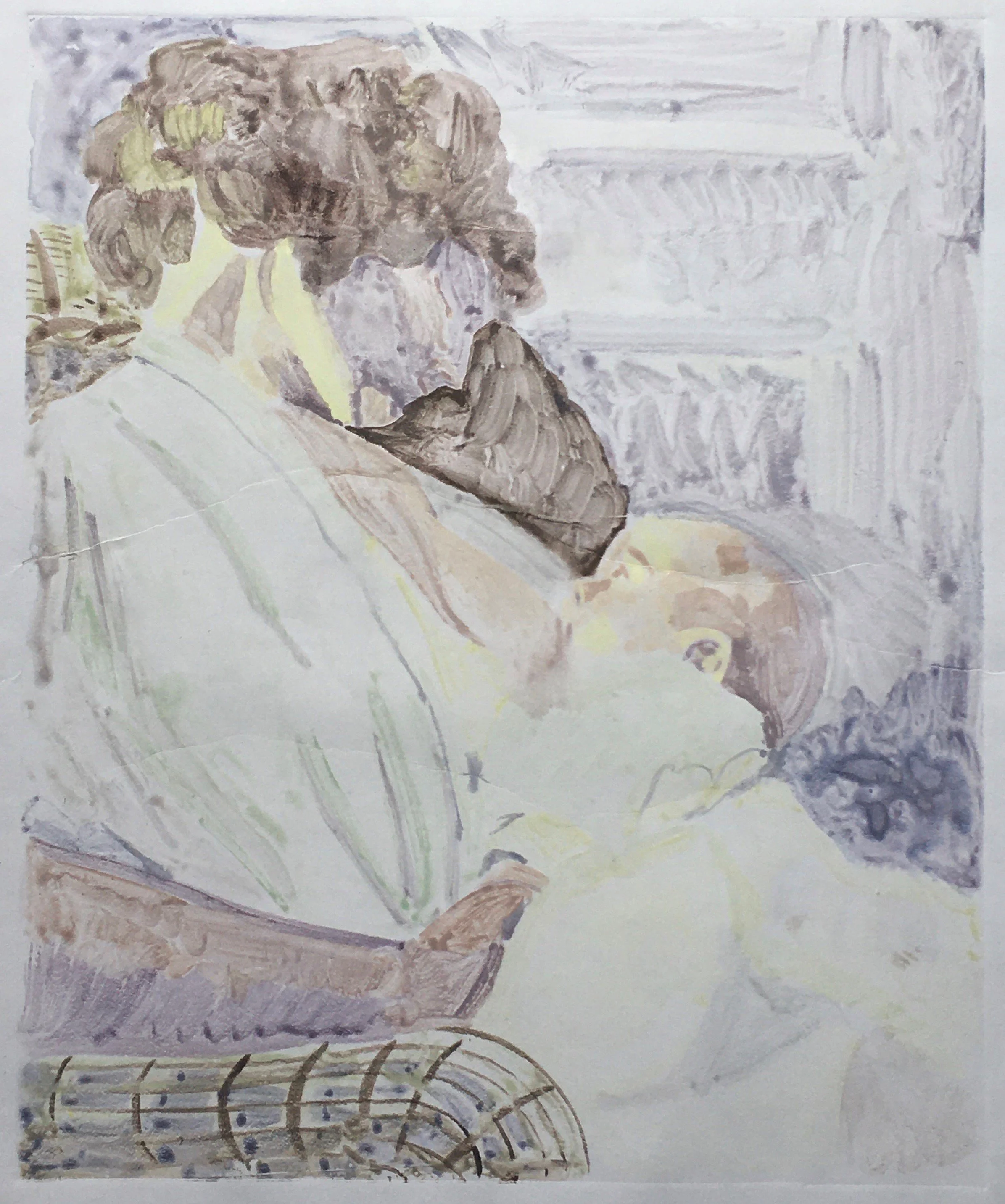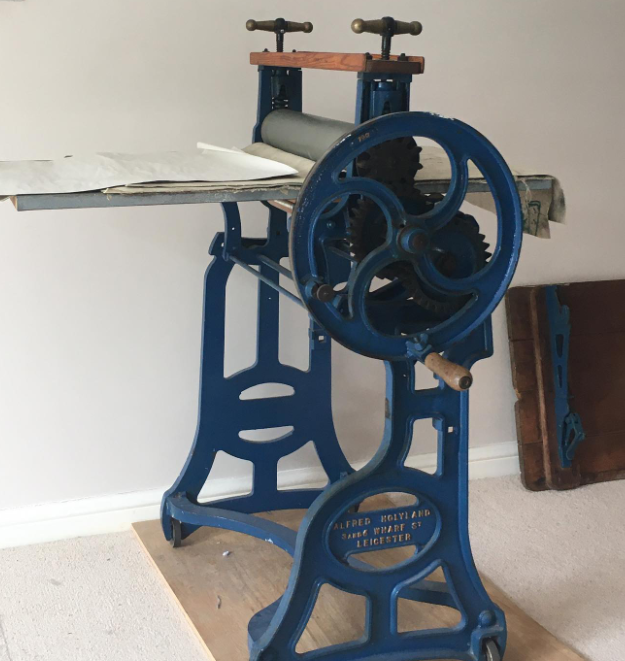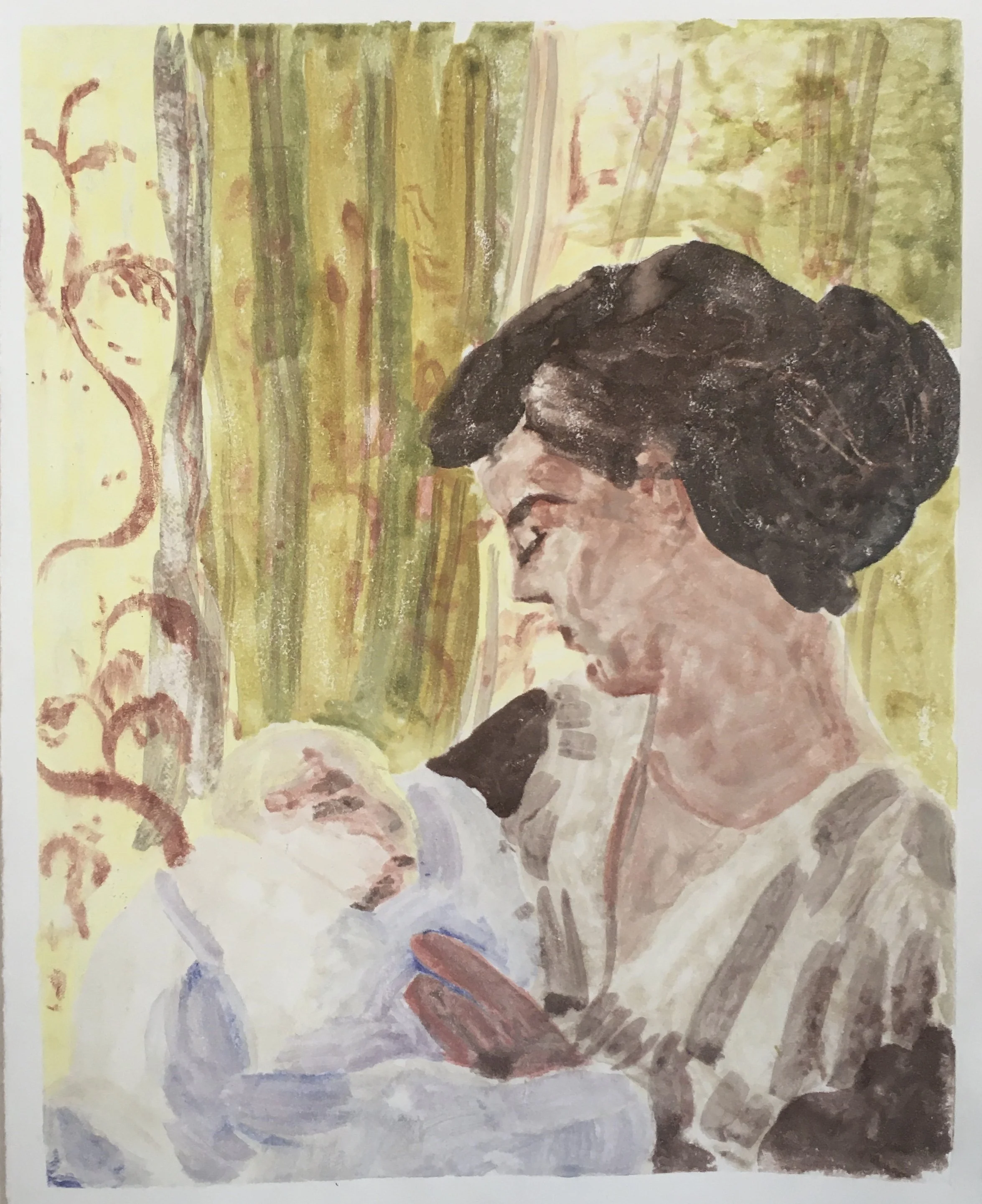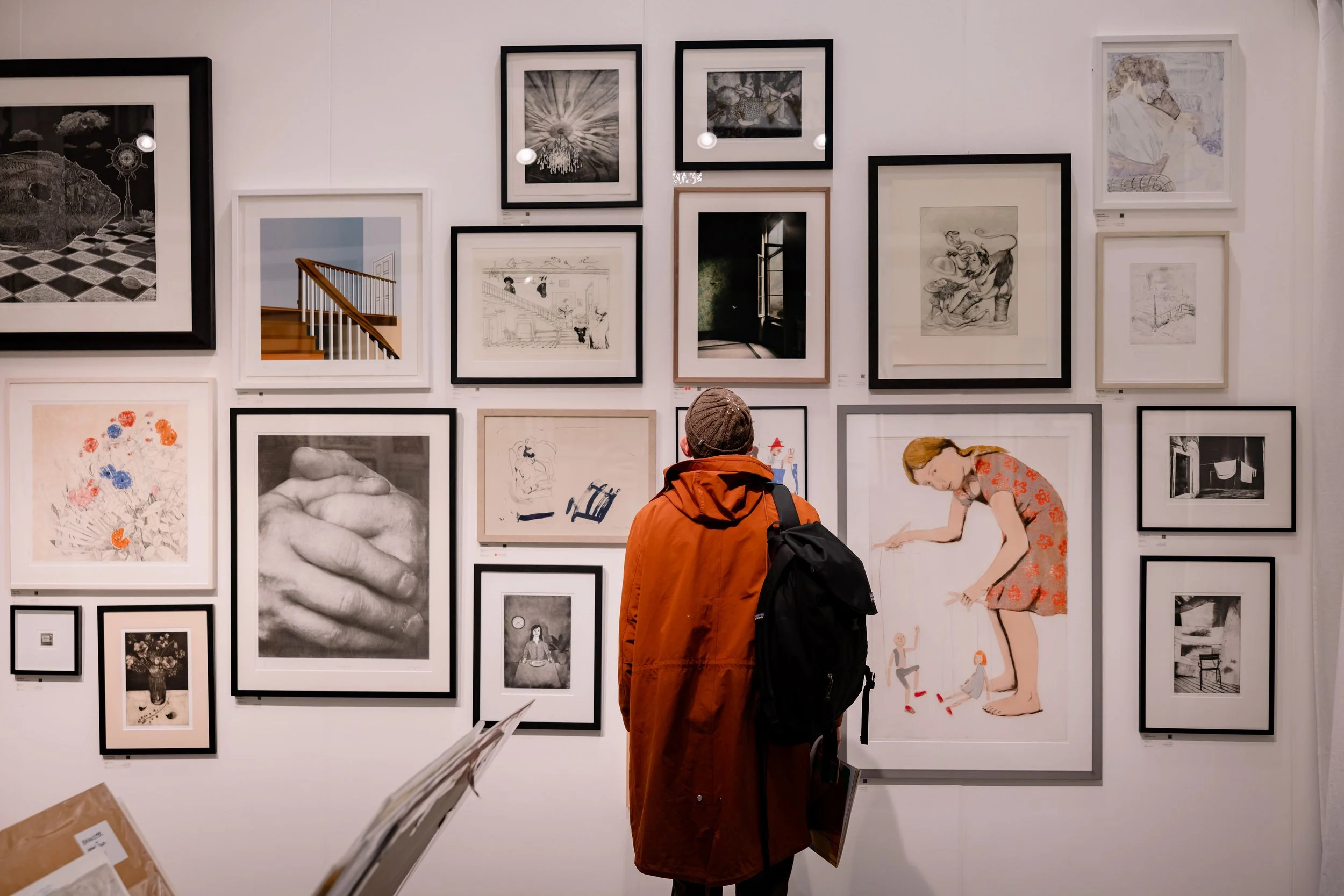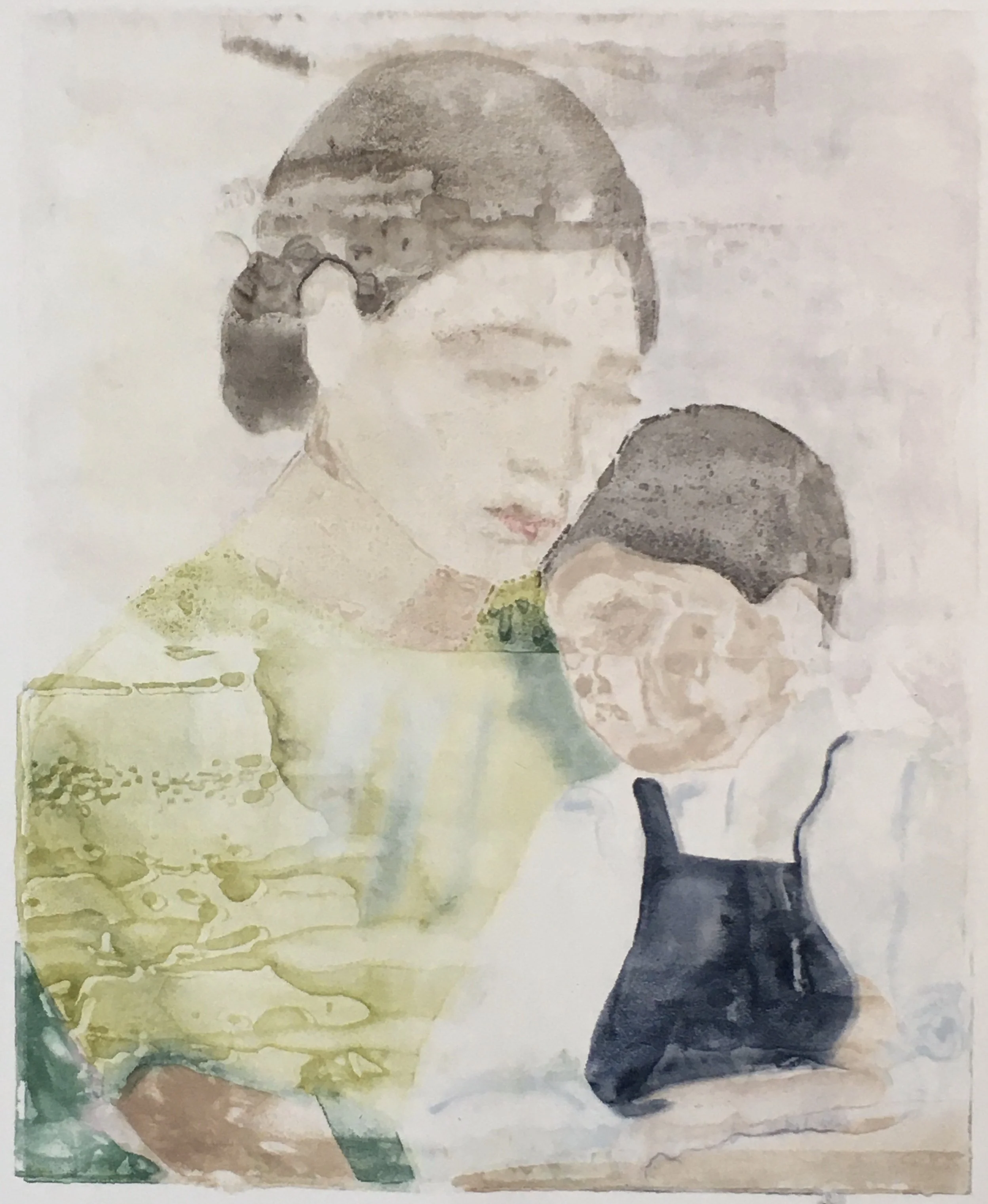Interview | Katherine Allen
Untitled (Vivien), 2022, Monotype, 50 x 39 cm, Unique work
Katherine Allen is an artist living and working in West Sussex. She exhibited at Woolwich Contemporary Print Fair 2022 was shortlisted for the Boodle Hatfield Printmaking Prize.
Primarily a figurative artist, Katherine explores themes of women, domesticity and motherhood. Her work is a reflection of the current stage of her life and is a way to work through the delicate balance between her multiple roles as mother, professional and artist.
We were delighted to exhibit your work as part of Woolwich Contemporary Print Fair 2022. For those who aren't familiar with your artwork, could you start by introducing yourself and your artistic practice?
I'm an artist who mostly makes monotypes. I’ve recently been experimenting with silkscreen monoprints, which has been fun to try something new. My studio is at home and my work tends to focus on people, mostly women and mothers. I guess it's reflective of me, I'm a mother and I have two kids. I have a lot of thoughts about that part of my life and making images based on this is my way of thinking and working out for myself what I expected it to be like and how it's different.
I went to art school and during my foundation year I was introduced to printmaking and drypoint. I completely fell in love with it so from then I went from my foundation to study a BA, which was a general fine art course but I spent all my time in the print room. I didn't actually finish the BA, I stopped after two years and went on to do a postgraduate one year course in art conservation, specialising in works on paper back at Camberwell. I was working with amazing prints and etchings conserving them - I was in my element! I then went on to get a professional job in the city for which I had to sit lots of exams and when I qualified, I instead wanted to take some time for myself. I went part-time and I took a course at Morley College in printmaking. It was brilliant and that reignited my passion.
Then I had my first child and I think having kids made me more focused in that I needed to carve out time properly for myself. So when I had my second child, that’s when I really started to knuckle down. I've always loved art and making, particularly printmaking from when I was first introduced to it on that foundation course. Work and children can take up all the time and so having something else that’s just for myself is really important.
Heavy weight, 2022, Monotype gouache on paper, 35 x 42 cm, Unique work
Your artwork Untitled (mother) (2022) was selected as a Top Pick of WCPF22 by Fair Directors Jack Bullen & Lizzie Glendinning. They chose this piece, in their words, because ‘we’ve recently had two babies and these gentle depictions of motherhood really resonate so much with us.’
Can you talk to me more about Untitled (mother) and the inspiration behind it, picking up on some of the things that you've just spoken about and how you're using this particular piece to reflect on them?
I was thrilled to be chosen by Jack and Lizzie and was very happy to be a part of Woolwich Contemporary Print Fair. My children are starting to get a little bit bigger now, they are six and three, so they’re no longer babies, even though this image is of a mother and small child. When I was making this piece, although it's not a portrait of me and my child, it was a way for me to think about and remember those quiet moments because I think when you're in the thick of raising small children, it's really hard. It can be brutal and I know that I didn't always take the time to appreciate those moments. When I was making this work, I was carving out time to appreciate and imprint those memories in my brain before I forget what it was like.
Untitled (mother), 2022, Monotype, 49 x 39 cm, Unique work
Although you said YOUR WORK ISN’T A DIRECT portrait but a symbol or a way of you reflecting back on your own life, I wonder where the imagery stems from?
I'm a bit of a magpie when it comes to imagery and I use a lot of reference images. I'll often take a snapshot and come back to it when I've got time in my studio. They are usually of people I don’t know and I find that easier, I think. If I was to try to do a portrait of myself and my child, there'd be so much going on. If it's not me then the image and the figure become an empty vessel for me to think about things in relation to myself, my life, or to my own children.
Untitled (Bebe), 2022, Monotype gouache on paper, 19 x 24 cm, Unique work
I think it’s interesting this idea of the image as an empty vessel for your projections and own feelings to flood into. There is also a muted tonality in your work, emphasised by the formal bleeding between colours and thinly applied gouache. To me, this creates distance between the image and viewer - the figures appear in a dream-like or contemplative state as they gaze beyond us. It is as though we’re intruding on their domestic moments of quiet intimacy.
What draws you to monotypes as a method? Could you expand on this process and how it informs the final image?
I love any kind of printmaking but I’m time-poor and so monotypes are really great for me. Overall, I love the blurring technique you can get and the surprise element of it, especially as I think I can be quite controlled and I’m always concerned with overworking pieces. But with monotypes, I don't have total control of the outcome and this allows me to let go. This spontaneity is why I have gravitated toward monotypes.
Everything I use is water-based, my studio is at home and I can't really deal with the clean-up of the oil. For a plate, I'll use a piece of glass or Perspex, which I coat in gum arabic. I use this to help the paper and pigment lift off the plate more easily and smoothly. I allow it to dry, then it's ready to go. I paint on the plate using gouache and when I'm happy with the painting, I'll take an impression with a damp piece of paper.
I do have a small press, it was actually the first thing I bought with my first pay cheque and has sat with me for the last 15 years. I’ve hauled it around as I’ve moved to different places. Now it gets the occasional use if I'm doing a bigger print but I’ll hand burnish mostly. It sounds pretty low-fi but for me, they give similar results. I think it's great that I can do it at home without needing to travel into a studio because I've got limited time to do this between dropping off my kids to school and picking them up, which always comes around incredibly quickly.
One of Katherine’s first monotypes: Untitled (yellow curtain), Monotype, 19 x 24cm, Unique work
My brain is like a Filofax of reference images and I’ll just try piecing them together compositionally, trying them out and making decisions about colour. I tend to keep my colours relatively limited and muted. I like the economy of using a limited palette and find the restriction an interesting process. Often details get lost in the printing process but I love the blurring that monotype brings to the final image. Sometimes the detail that is lost is a bit of a surprise but I'm okay with that. It also can’t rework it so you can’t really worry about any mistakes because you can't fix them and you just have to keep moving forward.
Untitled (Elfie), 2023, Silkscreen monoprint, 20 x 24cm
You have recently been experimenting with silkscreen monoprints, how has this changed and evolved the ways you approach printmaking?
It does feel quite different, I think. You're working on a screen and instead of something flat and smooth, the screen sucks up the paint, as opposed to the plate where the paint sits on top. With the monoprints I can get a couple of images from each. Whereas the monotype is just the one. With the multiples, each one's coming out fairly different, so that's new to me. On some of them, I have been overlaying a second layer of print, seeing what does and doesn’t work. I'd never done two layers for a monotype so it’s added some different aspects and brought a different set of textures and brush marks, or lack of them. I’m finding that the prints are coming out very smooth and losing some of that painterly quality in a way that you have in the monotypes but I'm enjoying this process and trying something different.
Untitled (Elfie), 2023, Silkscreen monoprint, 20 x 24cm, Detail
It's interesting how the monotype and silkscreen monoprint can feel so closely related as a medium but as you’ve highlighted, the concerns that you're facing feel so different and how that's affecting the work. Has it given you freedom and allowed you to be less precious with individual pieces?
It’s allowed me to work back into the prints because I have another one, in case something goes wrong. I can be quite precious and worried about how things turn out and what it’s going to look like. I need things to push me past that and I think I've been choosing these types of printmaking because it pushes me into that uncomfortable space within my practice that I don't naturally inhabit. I can see the work benefits immensely from doing that. At the moment, I am asking what can I do with the second image? What does it mean? Do I keep it or do I throw it away? What is its value to me? And I haven't haven't figured that out yet. It’s very unpredictable.
Untitled (Anais), 2023, Silkscreen monoprint, 20 x 24cm
You’ve spoken about the delicate balance between your roles as mother, professional and artist and how your artwork becomes a way of understanding and reflecting on this. Can you talk to me more about this?
I think about this a lot. I think anyone who is a parent and works, there are so many demands on your time and all those roles that you have could take up all of you. So in my life, being a mum, having a job and my art practice, there's always an antagonism and a need for more time, but making sure that I have an art practice is a way for me to carve out my role as an artist and to maintain it. When I make my work, I'm often thinking about those things or it’s a reflection of how I'm feeling. Sometimes the women in my pictures are very tired or they're at rest and taking a pause in their otherwise extremely busy life. I think my art practice is me taking that pause from my other obligations. What I love about this time in my studio is that I don't think about anything else and it's a huge luxury that I'm very grateful for and I value so greatly.
Untitled (red top), 2022, Monotype, 42 x 34 cm, Unique work
Hettie Judah has recently published the book How Not to Exclude Artist Mothers (and other parents), which argues that we need to rethink, restructure and remodel the art world to take account of the needs of artist-parents. Does this resonate with your practice and this blurring of roles that we have spoken about?
I’m totally supportive of the idea of better accommodations for parents, especially mothers who pick up the majority of childcare, not just in the art world but everywhere. I think it’s amazing that people, like Hettie, are talking and publishing books about this because it all leads to better awareness and to change for the better.
Some of the things we could change are so simple, like the timing of private views and not doing it at bath and bedtime. It’s so simple but I think if you're not a parent or don’t have these responsibilities then you might not think about that. It’s so important that people are speaking about how to make simple practical accommodations, which are inclusive to parents but really benefit everyone in the long run.
Untitled (mother), 2022 at Woolwich Contemporary Print Fair 2022
And finally, who are your artistic inspirations? How have they influenced the ways you approach your own work?
I'm just looking around my room because I've got some studies that I did of other artist’s work, so I've got Mary Cassatt hanging up, she's an incredible printmaker. It just blows my mind how innovative she was, always pushing her printmaking. I like a lot of Impressionists, such as Pierre Bonnard and Berthe Morisot. I just love their paintings and the colours that they use. But what's been really influential for me was joining Instagram. I'm not part of a group of artists in a studio, so I found a lot of artists on Instagram who are so inspiring to me. It's amazing to see what work they’re making, a lot of them are women and mothers. I found it also liberating because there is such a wide variety of work and they’re just putting it out there in the world, and I just thought maybe I can do that too.
Untitled (goddess), 2023, Silkscreen monoprint, 20 x 24cm
Katherine Allen’s work is available to purchase as part of our Celebrating Women in Print. For this month only, we have curated a selection of our favourite WCPF women artists for a limited online sale. Discover more here.
Find more Printmaking Inspiration here.
Discover more printmaking techniques here.
Woolwich Contemporary Print Fair, 26 - 29 October 2023. Details here.
Thanks to our partner Boodle Hatfield LLP.



